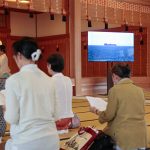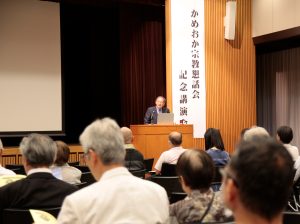1. About Divine Signposts
1) Divine Signposts is a sacred text written by DEGUCHI Onisaburo, the Co-Founder of Oomoto (1871-1948). Imbued with the divinity of the Spirit of Mizu, he wrote it in 1904, at the age of 33 years, in Ayabe, Kyoto Prefecture, Japan.
That year was the 12th year since Oomoto’s founding by the Divine possession of DEGUCHI Nao, the Foundress of Oomoto (1837-1918), and the fifth after Onisaburo’s joining Oomoto.
2) In 1898, six years before writing this book, DEGUCHI Onisaburo, under Divine guidance, made a one-week journey of exploration in the spiritual world, undergoing bodily asceticism in a rock cave on Mount Takakuma near his birthplace. Under the frosty sky and only lightly dressed, with neither food nor drink, he sat on the rock for one week; during this time his soul travelled to the spiritual world through the realm of heavenly beings and hell. It was then that he became aware of his mission of world salvation.
3) The text of this book is one of Onisaburo’s earliest writings; in 14 Japanese-style volumes, he dealt with the basis of Oomoto’s teachings, the essence of faith, his mission of world salvation and others matters in the simplest terms possible for the believers of the time.
4) Beginning in 1919, 15 years after they were written, these 14 volumes were published in serial in the Oomoto organ Shinreikai, and in 1925 they were first published together as one book by the Oomoto organisation, with the title Divine Signposts.
5) Later, in 1948, after the Second Oomoto Suppression (1935-45) had been resolved, the Oomoto organisation reissued Divine Signposts, taking as its text the edition published in 1925; and in 1985 it was recompiled and published in a more extensive edition.
6) The present book has been compiled on the basis of the edition of 1985 as a scriptural text of Oomoto for non-Japanese believers.
2. About the compilation of this book
1) The compilation of this international edition of Divine Signposts was undertaken by the Department of Doctrinal Study and Research of Oomoto. The aim was first to translate it into Esperanto and then into various national languages, for non-Japanese believers in the world who cannot read the scriptures of Oomoto in the Japanese language.
2) We proceeded with the work of compilation with the following plan:
a) We removed certain parts, namely peculiarly Japanese expressions which would not be understood internationally.
b) In the edition of 1985 the book consisted of 4 parts and 14 chapters, but in the original text each part formed a separate, independent booklet. Consequently, when it was published in single-volume form, it contained many sentences in which the same content was repeated. In the present edition we have weeded out these superfluous repetitions as far as possible.
c) In the 1985 edition each part was divided into 3 chapters, “upper”, “middle” and “lower”, and each chapter consists of paragraphs numbered consecutively within that chapter. For the present edition, however, because there arose gaps in the numbering owing to the deletion of certain passages as mentioned in a) and b) above, we have revised the numbering system, that is, we have numbered all the paragraphs consecutively, disregarding the chapter framework.
The work of translation into Esperanto was given to MAEDA Shigeki, a member of EVA (the Association of Esperanto Writers) and a director of EPA (the Oomoto Society for the Promotion of Esperanto). In order that the translation should be faithful to Oomoto doctrine, we had detailed consultations with the translator on such questions as how to translate doctrinal terms. In particular, we concentrated our attention on Oomoto’s doctrine regarding God, because it has many points which cannot be explained in terms of the concept of the divine in other existing religions.
1) About the spelling of names of God
Oomoto’s doctrine concerning God is unique compared with those of other existing religions, containing as it does elements of monotheism, pantheism and polytheism. Consequently, the concept of the divine is very wide-ranging, and is hard to express correctly using existing writing conventions.
Therefore, for this edition we have adopted the following procedures:
a) For the names of the one and only God or Creator, who is an absolute and infinite presence, we have used small capitals throughout the book; pronouns which refer to this GOD are written with a capital initial letter to distinguish these pronouns which refer to another God (or god).
E.g.: The God who created everything in the universe is one only: He is called the GOD AMENOMINAKANUSHI. (81)
b) Before the proper name of a God who is a second-degree manifestation of the one and only God and who is His direct part-spirit (as for example the rulers of the sun, moon, earth and other), we have used the word “God” with a capital initial letter.
E.g.: The spirit of the God Susanoo is the Spirit of Mizu. (115)
c) Those spirits, who are part-spirits of the one and only God and who are His activists, i.e. heavenly beings (the spirits residing in the realm of heavenly beings), are called “gods” in Oomoto. In this case we have used the word “god” with a lower-case initial to distinguish these from cases a) and b). (We have used the word “god” rather than “angel”, because the concept of angels in Christianity and other religions is not necessarily the same as that in Oomoto.)
E.g.: The god Konohanasakuya-hime (570)
2) About the explanatory notes
For ease of reference, the explanatory notes are arranged in two ways: when the explanation is brief, it is inserted, in parentheses, after the word concerned; when the explanation is longer, it is inserted immediately after the paragraph concerned, always in this special type.
3 March, 1997
Oomoto Doctrinal Committee



